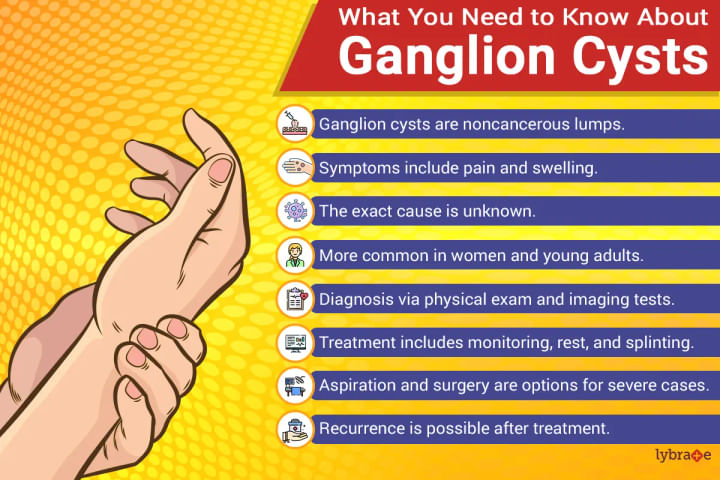Ganglion Cyst: Symptoms, Causes, Risk-factors, Diagnosis and Treatment
The body part, like the wrist or hands, is sometimes noticed to have a lump-like structure , which appears along the tendons and joints of the wrist or hands, and is called Ganglion cysts. They can also lump at the ankle or feet. Ganglion cyst found at the hand and feet are oval or round in shape.
They are filled with jelly like substance/fluid. As people understand it as cancer but it's not a cancer. Ganglion size is of peanut length with round in structure. Their size can be changed into big. These ganglions when occurring at nerves going along those joints, there will be pressure on the nerve which causes pain and sometime due to its size and pressure putting to never there will be resistance in the movement of joints.
When ganglion cyst causes problems by lengthening its size we go to a health provider to drain the fluid inside the cyst with the help of a needle. There can be the option of removing it surgically. Sometimes there are no symptoms for which treatment is not necessary. Many times these ganglions occur at joints that have good size and then start to reduce in size and after shrinkage they disappear from that place.
Symptoms:
When ganglion occurs there are some signs in the body to notice. Such sign are in the following paragraph:
LOCATION AND PAIN : The body part, like the wrist or hands, is sometimes noticed to have a lump-like structure; this appears along the tendons and joints of the wrist or hands, and is called Ganglion cysts. They can also lump at the ankle or feet. Ganglion cyst found at hand and feet are in oval or round 9n shape. They are filled with jelly like substance/fluid. As people understand it as cancer but it's not a cancer. Ganglion size is of peanut length with round in structure. Their size can be changed into big. These ganglions when occurring at nerves going along those joints, there will be pressure on the nerve which causes pain and sometime due to its size and pressure putting to never there will be resistance in the movement of joints.Sometime there are no symptoms for which treatment is not necessary. Many times these ganglions occur at joints that have good size and then start to reduce in size and after shrinkage they disappear from that place.
When to see a doctor: when there is a lump or pain in the wrist or ankle or foot please go to a health provider. Please get a diagnosis done and see if treatment is necessary.
Causes
There is no evidence of its causes why it occurs at joints . It always grows out of joints or tendons with fluid filled in it. This fluid is thick and its composition is like fluid found inside joints and in the lining of tendons. And there is no reaction or injury causing it to occur.
Risk factors
As there is no particular cause of ganglion but there are few risk factors which are responsible for this. Which are following:
Sex and age: Ganglion cysts can occur at the wrist or ankle to anyone at any age. But they mostly develop to women in particular that age from 20 to 40 years. .
Osteoarthritis: people who suffer from arthritis in the finger joints or at the ankle. This arthritis causes wear and tear in the joints which increases the risk of ganglion cysts at ankle and wrist joints.
Joint or tendon injury: when there is heavy injury to joints or tendons there might be more chance of ganglion cyst occurring.
Diagnosis:Health care provider checks it first by pressing the thumbs along the cyst whether there is pain or not. he/she might use a torch to see inside the cyst whether it is made of solid or fluid. Having imaging tests like MRI OR X-ray filter out the other conditions like arthritis or tumor at the joints. To confirm or to run a test on fluid inside, fluid from the cyst is drawn out with the help of a needle. Note: ganglion cyst fluid is thick and transparent.
Treatment:
Ganglion cysts are sometimes painful and sometimes painless. For painless there is no treatment necessary but the cyst can be removed because it does not look nice. painful ones change their size regularly and hindrance in the way of movement of wrist or ankle for them we need some treatment:
Keep the joint from moving: any movement at the wrist or ankle may be one of the causes of growth of ganglion cyst. So keeping it in place by using the splint or a brace might help in reducing the size of the cyst. And as the cyst shrinks in size the pain at nerves comes down. We should not use splints and braces for a long time because it might weaken the muscle around the joint.
Drain the cyst: with the help of a needle we can drain the cyst to relieve the pain in the nerve but this can grow after some time.
Surgery: this is the last approach to cyst if other methods won't work. Surgery is done by removing the cyst with its stalk that is attached to tendons or joints. Surgery damages the nearby area so many people avoid it. However, the cyst can come back after the surgery.
Conclusion:
Ganglion cyst occurs like a lump at the joint of the wrist or ankle. This is filled with fluid like ganglion and is painful. Please do not perk it with yourself go to the doctor for doing this because it might cause you infection. For any further information on surgery please visit the doctor.



+1.svg)
